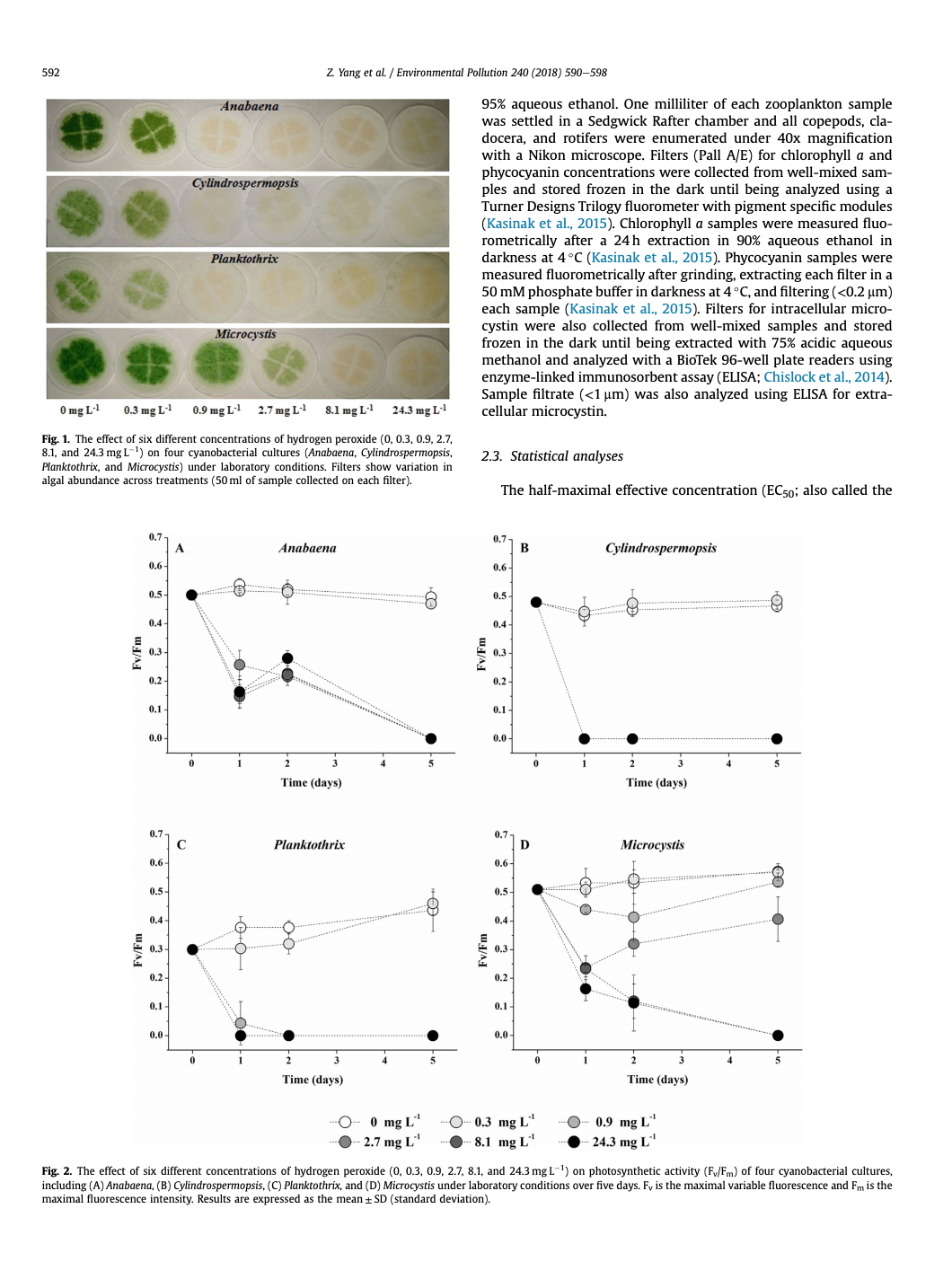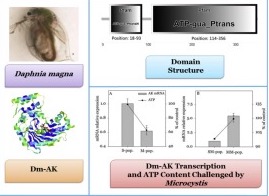Keyword: Zooplankton

Yang, Z., R. P. Buley, E. G. Fernandez-Figueroa, M. U.G. Barros, S. Rajendran, and A. E. Wilson. 2018. Hydrogen peroxide treatment promotes chlorophytes over toxic cyanobacteria in a hyper-eutrophic aquaculture pond. Environmental Pollution 240:590-598.
Abstract
Controlling blooms of toxigenic phytoplankton, including cyanobacteria, is a high priority for managers of aquatic systems that are used for drinking water, recreation, and aquaculture production. Although a variety of treatment approaches exist, hydrogen peroxide (H2O2) has the potential to be an effective and ecofriendly algaecide given that this compound may select against cyanobacteria while not producing harmful residues. To broadly evaluate the effectiveness of H2O2 on toxigenic phytoplankton, we tested multiple concentrations of H2O2 on (1) four cyanobacterial cultures, including filamentous Anabaena, Cylindrospermopsis, and Planktothrix, and unicellular Microcystis, in a 5-day laboratory experiment and (2) a dense cyanobacterial bloom in a 7-day field experiment conducted in a nutrient-rich aquaculture pond. In the laboratory experiment, half-maximal effective concentrations (EC50) were similar for Anabaena, Cylindrospermopsis, and Planktothrix (average EC50 = 0.41 mg L-1) but were ∼10x lower than observed for Microcystis (EC50 = 5.06 mg L-1). Results from a field experiment in an aquaculture pond showed that ≥1.3 and ≥ 6.7 mg L-1 of H2O2 effectively eliminated Planktothrix and Microcystis, respectively. Moreover, 6.7 mg L-1 of H2O2 reduced microcystin and enhanced phytoplankton diversity, while causing relatively small negative effects on zooplankton abundance. In contrast, 20 mg L-1 of H2O2 showed the greatest negative effect on zooplankton. Our results demonstrate that H2O2 can be an effective, rapid algaecide for controlling toxigenic cyanobacteria when properly dosed.

Lyu, K., L. Zhang, L. Gu, X. Zhu, A. E. Wilson, and Z. Yang. 2017. Cladoceran offspring tolerance to toxic Microcystis is promoted by maternal warming. Environmental Pollution 227:451-459.
Abstract
Elevated temperatures and nutrients can favor phytoplankton dominance by cyanobacteria, which can be toxic to zooplankton. There is growing awareness that maternal effects not only are common but can also significantly impact ecological interactions. Although climate change is broadly studied, relatively little is known regarding its influence on maternal effects in zooplankton. Given that lakes are sentinels for climate change and that elevated temperatures and nutrient pollution can favor phytoplankton dominance by toxic cyanobacteria, this study focused on elucidating the effects of maternal exposure to elevated temperatures on the tolerance of zooplankton offspring to toxic cyanobacteria in the diet. Three different maternal thermal environments were used to examine population fitness in the offspring of two cladoceran species that vary in size, including the larger Daphnia similoides and the smaller Moina macrocopa, directly challenged by toxic Microcystis. Daphnia and Moina mothers exposed to elevated temperatures produced offspring that were more resistant to Microcystis. Such findings may result from life-history optimization of mothers in different temperature environments. Interestingly, offspring from Moina fed with toxic Microcystis performed better than Daphnia offspring, which could partially explain the dominance of small cladocerans typically observed during cyanobacterial blooms. The present study emphasizes the importance of maternal effects on zooplankton resistance to cyanobacteria mediated through environmental warming and further highlights the complexities associated with the abiotic factors that influence zooplankton-cyanobacteria interactions.

Lyu, K., H. Guan, C. Wu, X. Wang, A. E. Wilson, and Z. Yang. 2016. Maternal consumption of non-toxic Microcystis by Daphnia magna induces tolerance to toxic Microcystis in offspring. Freshwater Biology 61:219-228
Abstract
- Freshwater cyanobacterial blooms are a worldwide environmental issue. These blooms often comprise both non-toxic and toxic species and strains. Populations of some zooplankton, including Daphnia, have been shown to adapt locally to toxic Microcystis through maternal effects. However, Microcystis populations vary spatially and temporally in the absolute and relative abundances of non-toxic and toxic genotypes.
- We examined variation in induction of tolerance to toxic cyanobacteria in offspring from two Daphnia magna clones (JS and AH) fed diets containing Scenedesmus by itself or in combination with either a non-toxic or a toxic clone of Microcystis aeruginosa. The diets containing Microcystis included relatively more cyanobacteria within each week of the 3 week experiment (week 1–10%, week 2–20%, week 3–40%). Daphnia neonates were collected from these three treatments at the end of the third week and fed a diet containing Scenedesmus and toxic Microcystis for 3 weeks before a suite of life-history, physiological and biochemical measurements were made on the surviving animals.
- Neonates from mothers fed toxic and non-toxic Microcystis showed enhanced growth and reproduction compared to neonates produced from mothers fed only Scenedesmus. Our results showed that Daphnia neonates could be induced to tolerate toxic cyanobacteria when their mothers were fed diets containing non-toxic or toxic strains of cyanobacteria. Furthermore, elevated RNA–DNA ratios, superoxide dismutase activity and catalase activity in neonates fed diets containing non-toxic or toxic Microcystis clones suggested that the mechanisms behind these changes involved processes associated with metabolism and antioxidation.

Lyu, K., L. Zhang, X. Zhu, G. Cui, A. E. Wilson, and Z. Yang. 2015. Arginine kinase in the cladoceran Daphnia magna: cDNA sequencing and expression is associated with resistance to toxic Microcystis. Aquatic Toxicology 160:13-21.
Abstract
Nutrient loading derived from anthropogenic activities into lakes have increased the frequency, severity and duration of toxic cyanobacterial blooms around the world. Although herbivorous zooplankton are generally considered to be unable to control toxic cyanobacteria, populations of some zooplankton, including Daphnia, have been shown to locally adapt to toxic cyanobacteria and suppress cyanobacterial bloom formation. However, little is known about the physiology of zooplankton behind this phenomenon. One possible explanation is that some zooplankton may induce more tolerance by elevating energy production, thereby adding more energy allocation to detoxification expenditure. It is assumed that arginine kinase (AK) serves as a core in temporal and spatial adenosine triphosphate (ATP) buffering in cells with high fluctuating energy requirements. To test this hypothesis, we studied the energetic response of a single Daphnia magna clone exposed to a toxic strain of Microcystis aeruginosa, PCC7806. Arginine kinase of D. magna (Dm-AK) was successfully cloned. An ATP-gua PtransN domain which was described as a guanidine substrate specificity domain and an ATP-gua Ptrans domain which was responsible for binding ATP were both identified in the Dm-AK. Phylogenetic analysis of AKs in a range of arthropod taxa suggested that Dm-AK was as dissimilar to other crustaceans as it was to insects. Dm-AK transcript level and ATP content in the presence of M. aeruginosa were significantly lower than those in the control diet containing only the nutritious chlorophyte, Scenedesmus obliquus, whereas the two parameters in the neonates whose mothers had been previously exposed to M. aeruginosa were significantly higher than those of mothers fed with pure S. obliquus. These findings suggest that Dm-AK might play an essential role in the coupling of energy production and utilization and the tolerance of D. magna to toxic cyanobacteria.
Wilson, A. E., O. Sarnelle, and A. R. Tillmanns. 2006. Effects of cyanobacterial toxicity and morphology on the population growth of freshwater zooplankton: Meta-analyses of laboratory experiments. Limnology and Oceanography 51(4):1915-1924.
Abstract
We synthesized data from 66 published laboratory studies, representing 597 experimental comparisons, examining the effects of cyanobacterial toxicity and morphology on the population growth rate and survivorship of 17 genera (34 species) of freshwater, herbivorous zooplankton. Two meta-analyses were conducted with these data. The primary analysis compared herbivore population growth rates for grazers fed treatment diets containing cyanobacteria versus control diets comprising phytoplankton that are generally considered to be nutritious for zooplankton (chlorophytes and/or flagellates). This analysis confirmed that cyanobacteria were poor foods relative to small chlorophytes and flagellates. More importantly, filamentous cyanobacteria were found to be significantly better foods for grazers than single-celled cyanobacteria over all studies. Surprisingly, the presence or absence of commonly-measured toxic compounds (microcystins in 70% of the cases) in the diet had no overall influence on grazer population growth relative to control diets. A secondary analysis compared survival rates for grazers fed cyanobacteria versus no food. In contrast to the primary analysis, grazer survival was more negatively affected by toxic cyanobacteria than non-toxic cyanobacteria, relative to starvation. However, this difference was attributable to the effects of a single Microcystis strain, PCC7820. Thus, though some cyanobacterial strains appear to be toxic to some strains of zooplankton, the overall role of commonly-assayed cyanobacterial toxins as a determinant of food quality may be less than widely assumed. We suggest that more attention be focused on nutritional deficiencies, morphology, and the toxicity of undescribed cyanobacterial compounds as mediators of the poor food quality of cyanobacteria for zooplankton.